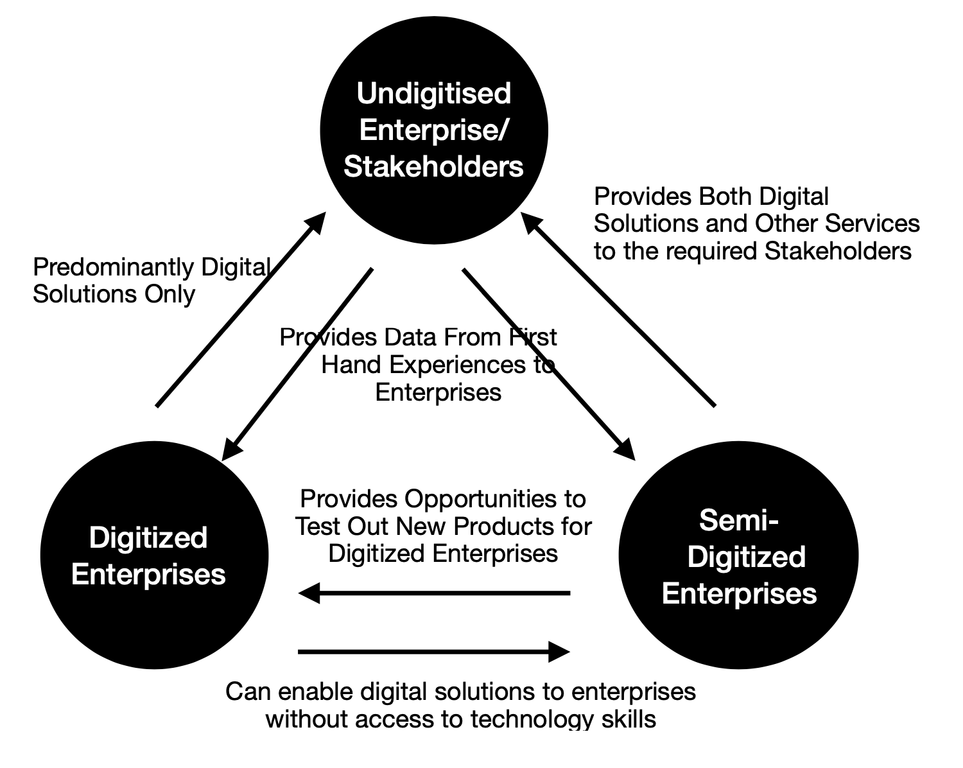Sampling and methodology
Submitted Mar 3, 2022
We aimed to interrogate how organisations attempted to implement beliefs and practices of open source software movements and compared it with the new model we have defined as open innovation, taking into account infrastructure, platforms, policies and market standards that provided a context on which local innovators can build.
We looked at the role stakeholders play in highlighting how open innovation in the country works on the ground, and so we focussed on conducting five roundtable discussions across five sectors. Additionally we conducted interviews for those unable to attend the roundtables. In all, 25 respondents participated in the roundtables and interviews.
The sectors chosen were
- Agriculture
- Education
- Finance
- Health
- Tech for development sectors.
We chose these five sectors due to the large-scale push by the government to use systems such as India Stack in these sectors. India Stack’s stated aim is to promote open innovation. The research asks whether such systems can be deemed open from the axes of access, empowerment and opportunity.
Additionally the research also aims to understand the various stakeholders currently observed in the country today. The research focuses on three layers of technology dependence
- Undigitized enterprises in the sector,
- Semi-digitized enterprises in the sector, and finally
- Digitized enterprises in the sector.
We viewed undigitized enterprises as the final individuals that aim to implement a technology solution for their work. A semi digitized enterprise would have created certain tech-enabled solutions in the systems used for work, while also engaging with final stakeholders. And finally digitized enterprises were focussed on the production of tech-enabled goals and outcomes targeting specific populations in the country.
In doing so we aim to understand how different stakeholders in each sector perceive and respond to systems currently in place for the propagation of technology enabled solutions. Thus we felt that it was not only important to speak to startups and industries that focussed on the creation of tech solutions, but also stakeholders who had to put these solutions into practice for their work and individuals who worked with both digital tools and human interactions in the creation of services. We hoped that through this approach of broader participation with both sectoral understanding and a more nuanced stakeholder representation we would be able to adequately answer questions of accessibility, empowerment and opportunity for a broader range of citizens and enterprises in the country.
This is due to the fact that no technology enabled solution exists in isolation, they often depend on various stakeholders to provide data or firsthand experience in the creation of any type of technological innovation in the country. Thus we believe that by looking at the ecosystem and providing a topographical understanding of the stakeholders in place we can produce a more nuanced understanding of open innovation.
Once we identified the various stakeholders for the research, we organized roundtable discussions. The roundtables were recorded with the respondents’ consent and were transcribed. All participants remained anonymous and were coded with unique participant IDs. To highlight themes and provide accurate analysis, the transcripts were coded through the process of open coding focussing on the themes of access, empowerment and opportunity. The study used the definitions made by the Mozilla Foundation’s “Reimagine Open: Building Better Internet Experiences” under which the definitions were: a) Access: the capability to reach the network, information, audiences, markets, and each other. b) Opportunity: the chance to participate in the network as an individual with minimal restraint, without gatekeepers, and with the ability to resist centralized control. c) Empowerment: a broad-based ability to create, shape, and participate in online experiences – in contrast with the pre-existing model of broadcast TV, where the only choice was what to consume.
Thus with the combination of the sampling strategy, coding structure and themes in place we believe the research and this report will provide a nuanced understanding of open innovation in India. Allowing us to form a broader understanding of what can be deemed as open.
Comments
Hosted by
Deep dives into privacy and security, and understanding needs of the Indian tech ecosystem through guides, research, collaboration, events and conferences. Sponsors: Privacy Mode’s programmes are sponsored by:
more




{{ gettext('Login to leave a comment') }}
{{ gettext('Post a comment…') }}{{ errorMsg }}
{{ gettext('No comments posted yet') }}